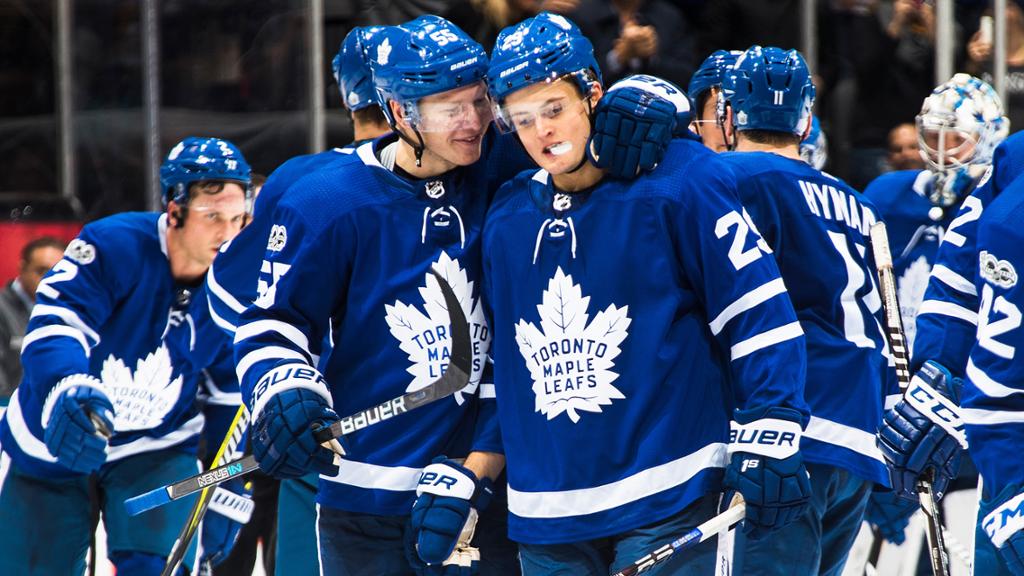The Toronto Maple Leafs extended their winning streak to five — four without Auston Matthews — with a 1-0 overtime win over the New Jersey Devils on Thursday night.
Your game in ten:
1. When a player like Auston Matthews goes down with an injury, besides losing an elite, game-breaking talent, it removes the protective bubble that he creates for the rest of the team. William Nylander and Mitch Marner were able to endure scoring droughts without a lot of heavy media or fan pressure when Matthews was in the lineup. Thankfully, both have now been able to break their slumps with only one article suggesting they be traded out of town (which might be a record for Toronto). Such is the benefit of having a superstar center on the team that can do it all at such a young age — it helps make it a safer environment for still-developing players like Nylander and Marner et al. Matthews is a human snow plow, of sorts.
2. William Nylander was really going in the first half of this game — two big shifts in the first period, three shots on goal, five of seven on the dot, and a nice defensive stop as the first forward back two minutes into the second that saved a near goal. He did trail off in the second half of the second period, and he was showing signs of “fighting it” in the third. But in overtime, he hit Rielly in-flight with a now-vintage Nylander tape-to-tape saucer pass that Rielly was unable to convert. He was very nearly wearing goat horns at 3-on-3, too; he got caught puck watching on the outside of the Maple Leafs’ 3v3 defensive structure and missed an assignment which led to a Taylor Hall point blank chance in OT — bailed out by a great Frederik Andersen save.
On a break the other way, Nylander laid out a pass for Kadri, who wasn’t where Nylander expected him to be (skating full speed driving the net). The Leafs were fortunate to be able to maintain possession in the corner, where an exhausted Nylander was able to walk out and beat Corey Schneider post and in.
The Leafs, who gathered 15 OT/SO losses last year, are now 5-0 in extra time to start the season.
3. Nylander admitted after the game that the goalless drought was on his mind:
I had a couple chances throughout the game & was a little rattled they didn’t go in. Nice to get it done in OT.
A 16-goal pace is well below the capabilities of a player with his skills and shot repertoire, and one expects this is the beginning of a turnaround in fortune coming off of a first quarter in which he led the Leafs in shots on goal (59, t-25th among NHL forwards).
4. Significant portions of the game featured uncontested or easy exits out of either defensive zone and short chips from the blue line and/or broken plays. There weren’t many long, extended cycle shifts like we saw against the Leafs from some of the Western Conference teams on their road trip. Much of the focus was on shutting down the neutral zone from both sides in what was a cagey contest between two very fast clubs; we could see signs of the explosive potential, but neither team wanted to open it up fully. It might have been a different story without some of the Corey Schneider goal-line robberies in the first period changing the complexion of the game.
5. After a solid first period where the Leafs got behind the Devils defense for some quality chances and outshoot New Jersey 12-10, the Devils’ speed through the neutral zone was starting to give the Maple Leafs trouble as it fed into their forecheck. Although there was no real hard forecheck established from either team for significant swaths of the game, starting in the second period, New Jersey began creating some outnumbered situations by isolating the Leafs D and creating scrambles below the goal line. In the second and third periods, New Jersey outshot Toronto 24-11.
6. Despite a good deal of skill and speed on both teams, it was a patient game underscored by fantastic goaltending from both Cory Schneider and Frederik Andersen. Schneider stopped a few point-blank chances in the first period, most notably JVR’s chance off a tip from his familiar PP spot. Andersen’s play was the real standout tonight from the Leaf perspective in the second, third and OT periods. With over .940 save percentage or above in four of his last six starts while facing 34 shots per game on average, he looks to be settling in again after a second consecutive season with a tough opening month and a bit. That’s the most significant sign of promise emerging out of this 4-0-0 run without Matthews.
7. Andreas Borgman’s growing confidence with the puck was on display again in this game. He created a few nice breakouts after working the puck out of danger down low. He almost put one in off a rush in the second period as he broke into the offensive zone on his off side, and he was one of few Leafs who was on the positive side of the possession ledger with a 58% CF despite tougher zone starts than usual. It’ll be interesting to follow Borgman’s development as the year goes on and if he might get a look on the PK at some point as he earns more trust. The first quarter has shown promising signs of steady progress.
8. The Hyman-Marleau-Brown line turned in a solid performance for the Leafs in this game. They rarely are subject to terrible defensive shifts, which is unsurprising considering the trio consists of three of the Leafs’ best defensive forwards. The trio led the team with 64%CF on the night.
It was a really good night for Taylor Hall and his line, who were flying and caught Nazem Kadri’s line looking a few times. Hall led his team with 18 shot attempts, disrupting the Leafs with his speed all night (up until his flyby in the 3-on-3 OT prior to the Nylander game-winner).
9. In what was another crazy 3-on-3 overtime, the Leafs gave up a 4-on-3 powerplay after Jake Gardiner laid a not-so-smooth pick on Nico Hischier off a rush chance in the offensive zone. The Leafs killed it off with big efforts from Andersen, Hainsey, and Zaitsev.
As the period of 4-on-4 began without a whistle, Rielly frantically pointed out — while carrying the puck — that the Leafs only had three men on the ice. With Gardiner staying on the ice after he came out of the box, they had two defensemen on the ice already, which was perhaps the cause of the confusion. A camera caught the mayhem on the Toronto bench, with just about everybody looking perplexed. Though it’s not clear what exactly happened, it’s a second instance in the last couple of weeks where a simple rule seemed to get past the coaching staff.
10. After going 4-1-0 in their five-games-in-seven-nights stretch last week, the Leafs will now be rewarded with another five games in seven nights starting this Saturday in Montreal. They’ll then follow it up with a road swing through Western Canada, and upon return, will play just one game in six days between December 3rd and 8th. After that breather, the Leafs will play two back-to-back sets in the same week in what will be another segment of five games in seven nights. Scheduling doesn’t get much crazier than this, and it wouldn’t be surprising if it plays into the team’s thinking about Matthews’ recovery — they’ll want him at 110% before jumping back into the grinder.




































